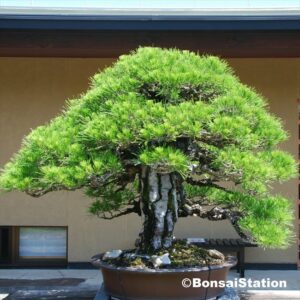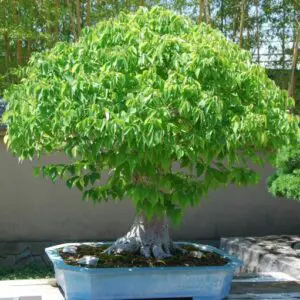Stoneware/porcelain is an ideal type of bonsai pot as it complements the beauty of a bonsai tree as a whole. In terms of bonsai tree health, a clay pot is most suitable due to its good aeration and drainage ability.
Types of bonsai pots
To choose the right pot for your mini bonsai tree, it is important to think about whether the pot matches the bonsai aesthetics and whether the pot keeps your tree healthy.
There are 3 types of bonsai pots in terms of the material they are made from.
- clay/terracotta
- stoneware
- porcelain
Clay

Clay bonsai pot
Stoneware

Stoneware bonsai pot
Porcelain

Porcelain bonsai pot
Clay pots

Clay bonsai pot
Clay pots are fired at low temperatures, usually below 1000 degrees celsius at around 800 degrees Celsius. When the material is fired at relatively low temperatures, it hardens enough but remains porous. This porous nature at the whole surface of pots gives them excellent aeration and drainage, favorable conditions for the growth of bonsai.
Stoneware pots

Stoneware bonsai pot
Stoneware is a kind of pottery which has the characteristics of both earthenware (=clay) and porcelain. Stoneware bonsai pots are in fact slightly different from stoneware, which is by definition non-porous and water impermeable; stoneware bonsai pots are somewhat porous and do have some aeration and water absorption ability.
Stoneware bonsai pots are fired between 1100 to 1250 degrees Celsius and are harder than clay pots. As the silicic acid in the raw material melts during firing, they are smoother than the clay pots and come in a variety of colors depending on the composition of the raw material.
Tokoname is very well known for manufacturing stoneware bonsai pots as well as Shigaraki and Yokkaichi.
Porcelain pots

Porcelain bonsai pot
Porcelain is a kind of pottery that is fired at around 1200 degrees Celsius and is strong, durable and hard to break. Porcelain bonsai pots are usually glazed in a single color or painted with multiple color images. With glaze, porcelain bonsai pots allow no aeration and drainage for the root system.
Bonsai pots type: Comparison table
| Clay/ Terracotta |
Stoneware | Porcelain | |
| Fire Temp | 800°C | 1100-1250°C | 1200°C |
| Glaze | Unglazed | Unglazed | Glazed |
| Water absorption | Yes | Almost none | No∗ |
| Porosity | Porous | No | Porous∗∗ |
∗ With glaze. Without the glaze, porcelain pots absorb water well.
∗∗ Water impermeable when glazed.
Bonsai pot’s type and bonsai tree’s health
The type of pots must be suitable for the physiology of the plants in order for bonsai trees to grow soundly. This means bonsai pots should be able to retain water yet remove its excess from the pot, give the roots sufficient fresh air, especially oxygen, and warm the roots to some extent.
The type of bonsai pots, i.e. their material, is the key to fulfilling this. The table below shows pots’ abilities of aeration, drainage and water retention by pots’ types.
| Clay/ Terracotta |
Stoneware | Porcelain | |
| Aeration | High | Mid-low | Low |
| Drainage | High | Mid-low | Low |
| Water retention | Low | High | High |
Best type of bonsai pots in terms of tree health
The best bonsai pots, as aforementioned, are those that have good aeration and drainage. Water retention of the pots should be considered if you live in a very hot and dry region, and/or if your work does not allow you to water your bonsai trees during hot summer days when needed.
In terms of bonsai tree health, an ordinary clay pot is the closest to the ideal as a bonsai pot. Clay pots have good aeration, drainage and adequate water retention, in addition to their heat absorption and dissipation ability which has a good effect on root growth.
Are porcelain bonsai pots good for bonsai trees?
In contrast, porcelain bonsai pots are not good for the sound growth of bonsai trees. Porcelain bonsai pots have no aeration or drainage through the pots, which is not desirable for the root system.
This means that the porcelain bonsai pots may actually obstruct the healthy growth of your bonsai trees. Young, growing or bonsai trees in the stage of training should not be potted in porcelain pots but be in clay/terracotta pots which have good airflow and drainage.
Porcelain bonsai pots should only be used when the tree is fully grown and ready as the bonsai tree.
How to improve aeration and drainage
Having said that, aeration can be improved by using porous soil allowing airflow from the surface and having more than one drainage hole.
The pot’s ability to drain water depends on the number and the size of drainage holes and the depth of the pots, besides the evaporation through the pots’ surface. The larger the size and the number of drainage holes, the better drainage. The deeper the pots, the better drainage.
Bonsai pot’s type and bonsai aesthetics
Bonsai is a natural landscape created with plants in a bonsai pot. In this sense, you must choose the pot that represents the scenery that you want to create in it. The pot should match the bonsai tree in terms of what the tree represents. It should feel stable, and the pot should complement the bonsai tree as a whole.
We can say that a bonsai pot is like clothes to a person or a picture frame to a painting. So, the type of pot is important in this regard.
Coniferous bonsai trees
Coniferous bonsai trees usually come with stoneware pots. This is connected to the notion of wabi-sabi, natural simplicity that praises imperfection and rustiness.
Coniferous bonsai trees symbolized a tree that withstands the harshness of nature such as wind, rain, snow or heat. They are regarded as strong with a thick trunk, coarse bark, and dense branches. This kind of simple natural beauty matches the earth-like color and stony/rocky texture of stoneware pots.
Deciduous/flower/fruit bonsai trees
Deciduous, flower and fruits bonsai trees, on the other hand, are usually potted in porcelain pots. These trees are vibrant, energetic and full of color with beautiful leaves, flowers and fruits. This kind of theatrical beauty best matches fine, decorative and lively porcelain pots.






